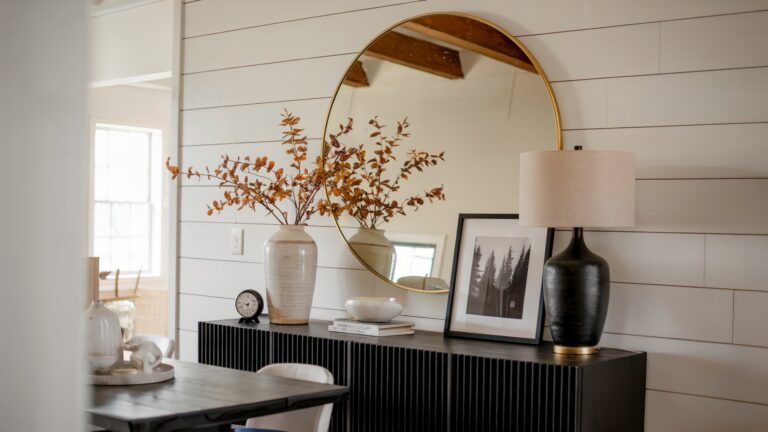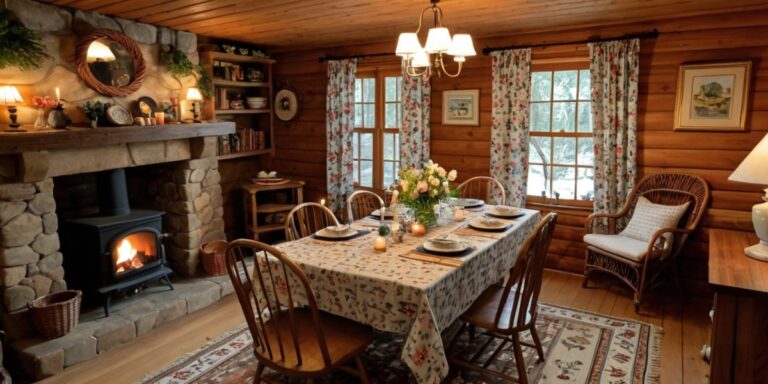After years of helping homeowners redesign their living spaces, I’ve learned that the perfect living room isn’t just about following trends—it’s about creating a space that truly reflects your lifestyle while maintaining both comfort and visual appeal.
Through various consultations and design projects, I’ve identified effective approaches that often deliver great results.
In my experience, one common mistake people make is copying Pinterest boards without considering their daily habits. I’ve seen beautiful rooms that look magazine-perfect but feel cold and uninviting.
That’s why I’ve curated these 21 living room designs based on client experiences and personal observations.
Note: For any electrical, structural, or major renovation work mentioned in this article, always consult with licensed professionals to ensure safety and code compliance.
1. A Cozy Living Room with Warm Accents

The foundation of comfort often starts with strategic color and texture choices. In my design work, I’ve observed that soft beige can create a good backdrop for layering—it tends to be forgiving with different lighting conditions and works across seasons.
The L-shaped sofa configuration shown here typically maximizes seating while maintaining conversation flow. I’ve noticed that round wooden coffee tables may help prevent bumping incidents compared to rectangular pieces, especially in family homes. Consider mixing pillow textures—combining linen, velvet, and knit fabrics often adds visual depth.
Suggestion: Try layering wool throws in different weights. Rotating them seasonally can provide both comfort and visual interest.
2. A Modern and Sophisticated Living Room

This sophisticated approach may appeal to those who want elegance without sacrificing daily comfort. I’ve used variations of this design in various homes, and it often delivers that refined-yet-livable feeling.
The beige sectional paired with a glass coffee table can create visual lightness. Rich brown curtains might add enough weight to ground the space. Consider that recessed ceiling lighting works best when dimmable; harsh overhead lighting can diminish evening ambiance.
Design consideration: Wall-mounted entertainment units are often positioned around 42 inches from the floor for comfortable viewing angles, though this may vary based on your seating height and personal preference.
Electrical work note: Consult a licensed electrician for proper recessed lighting installation.
3. A Chic and Contemporary Living Room
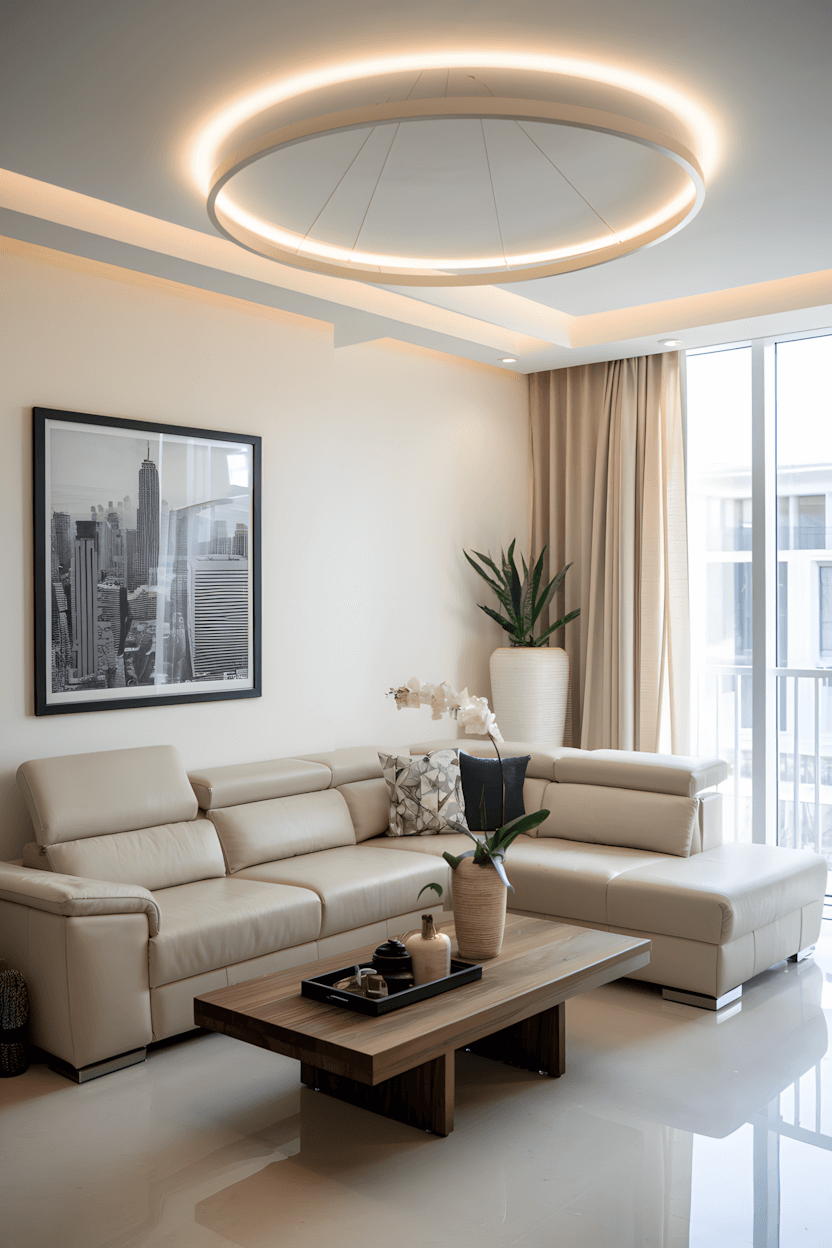
Circular light fixtures often become conversation starters. The key is typically mounting them about 30 inches above the coffee table; too high may feel disconnected, too low might obstruct conversation.
White tile flooring requires specific maintenance routines, but many find the visual appeal worth the effort. Consider adding one strategic pop of color through accent pillows or a carefully chosen area rug. Deep navy or forest green often provide lasting appeal without overwhelming neutral foundations.
Design tip: Monochromatic artwork typically works best in rooms with abundant natural light to prevent the space from feeling flat.
4. A Luxurious Living Space with Unique Lighting
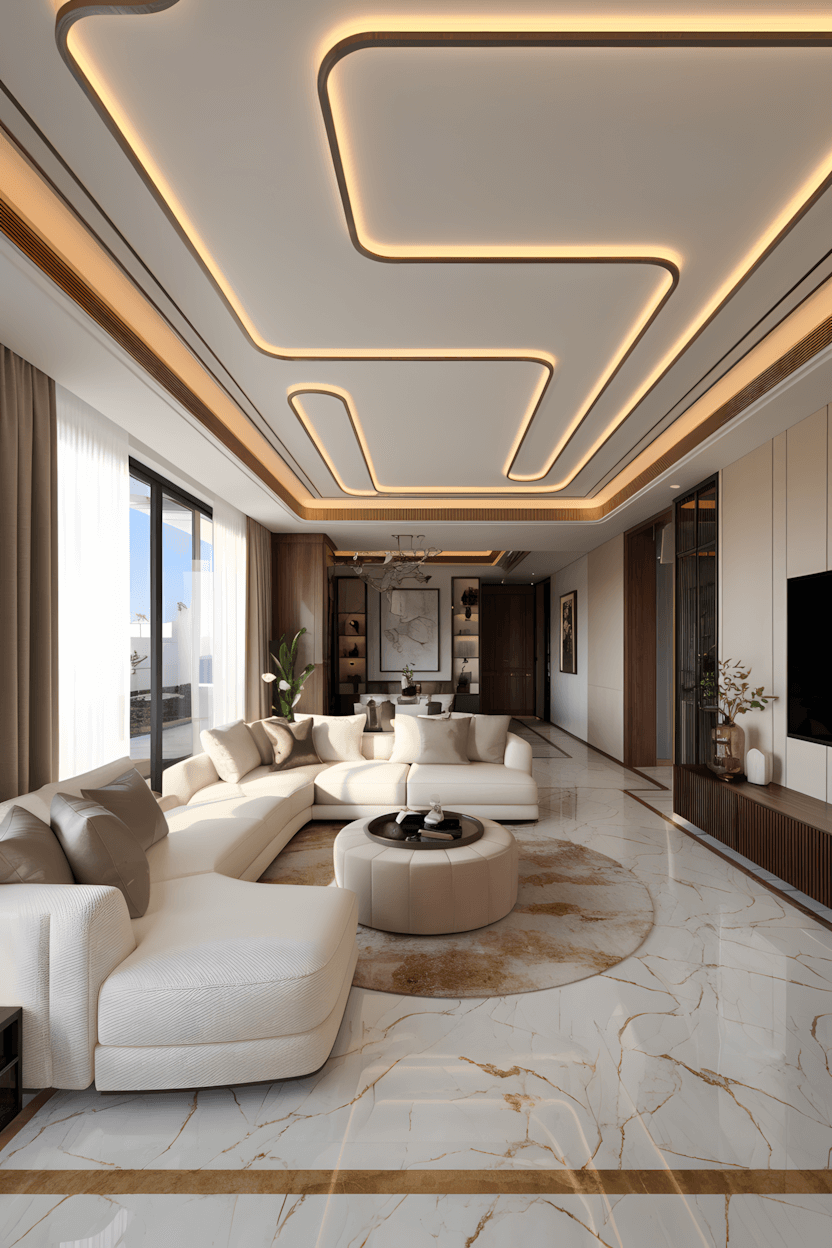
This serpentine ceiling lighting design represents a higher maintenance approach but can deliver significant visual impact. When working with marble flooring, subtle gold veining often works better than dramatic patterns, which some find overwhelming over time.
The off-white sectional choice can balance high-end materials without competing. Budget considerations should include potential additional costs for complex lighting installation.
Maintenance note: Glossy marble surfaces show footprints and water spots readily, so consider your household’s traffic patterns before choosing this finish.
Professional installation recommended: Complex ceiling lighting requires licensed electrical work.
5. Timeless Elegance with a Marble Backdrop
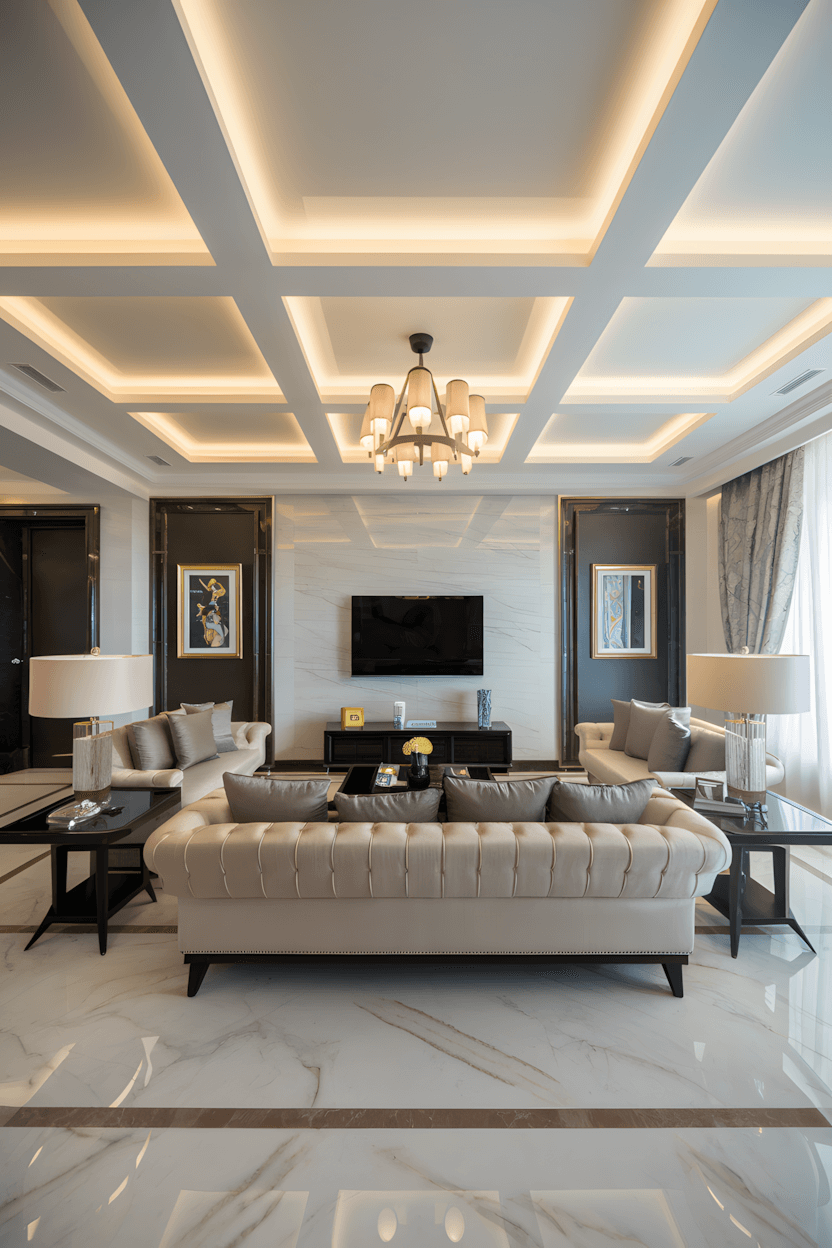
Coffered ceiling details require precise installation but may add perceived home value. This combination typically works best in homes with adequate ceiling height (generally 8 feet or more) for proper proportions.
Marble TV backdrops can work beautifully but require professional mounting for safety. Grand chandeliers need adequate ceiling height for both aesthetics and safety.
Proportion guideline: Many designers suggest choosing artwork that’s approximately 60% the width of your furniture piece beneath it for balanced compositions.
Safety note: Professional installation required for heavy chandeliers and wall-mounted displays.
6. A Neutral Haven with Gold Accents
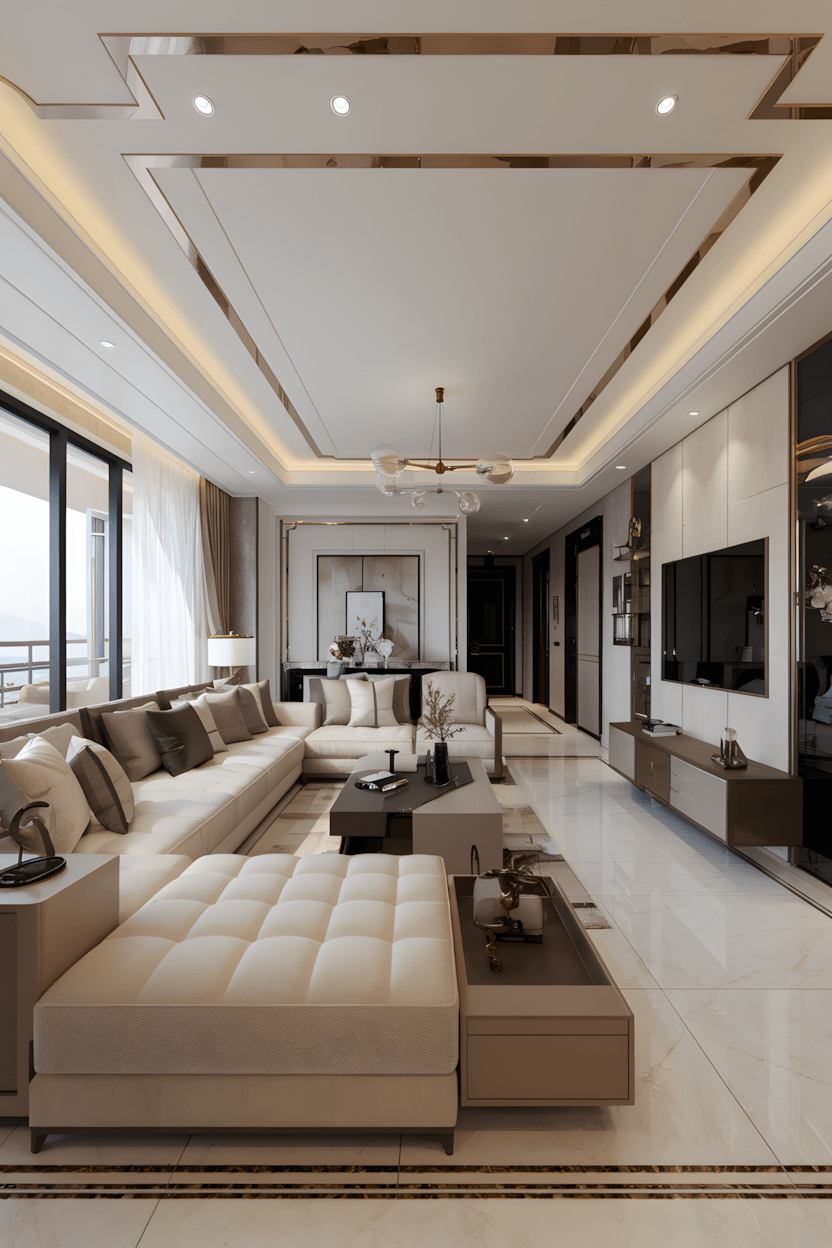
Some designers follow a “10% rule” for metallic accents—suggesting gold elements shouldn’t exceed 10% of visible room elements. This restrained approach often creates sophistication without overwhelming the space.
Rectangular coffee tables may work better in narrow rooms, while round tables might suit square spaces better. Careful measuring before purchasing can help avoid proportion issues.
Investment consideration: Quality recessed lighting with metallic trim often requires professional color matching for consistent results.
7. A Modern Living Room with Subtle Glamour
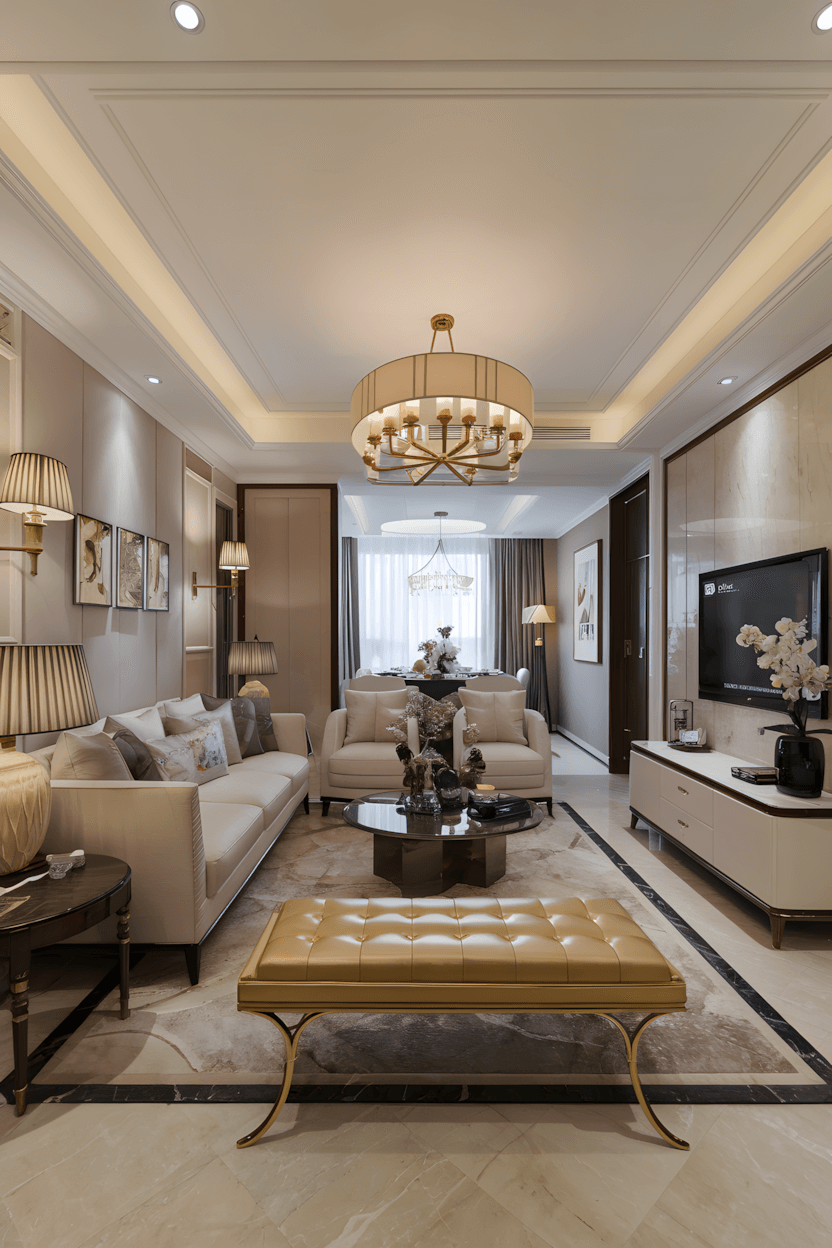
Statement chandeliers typically need adequate space to be effective. Tufted benches often work better as accent pieces rather than primary seating for daily use.
Striped wall-mounted lamps can create visual interest without overwhelming neutral foundations. These are commonly positioned about 18 inches from sofa arms for reading light, though personal preference may vary.
Design approach: Many designers limit rooms to three main colors plus one metallic accent to prevent visual chaos while maintaining appeal.
8. A Stylish Living Room with Warm Accents
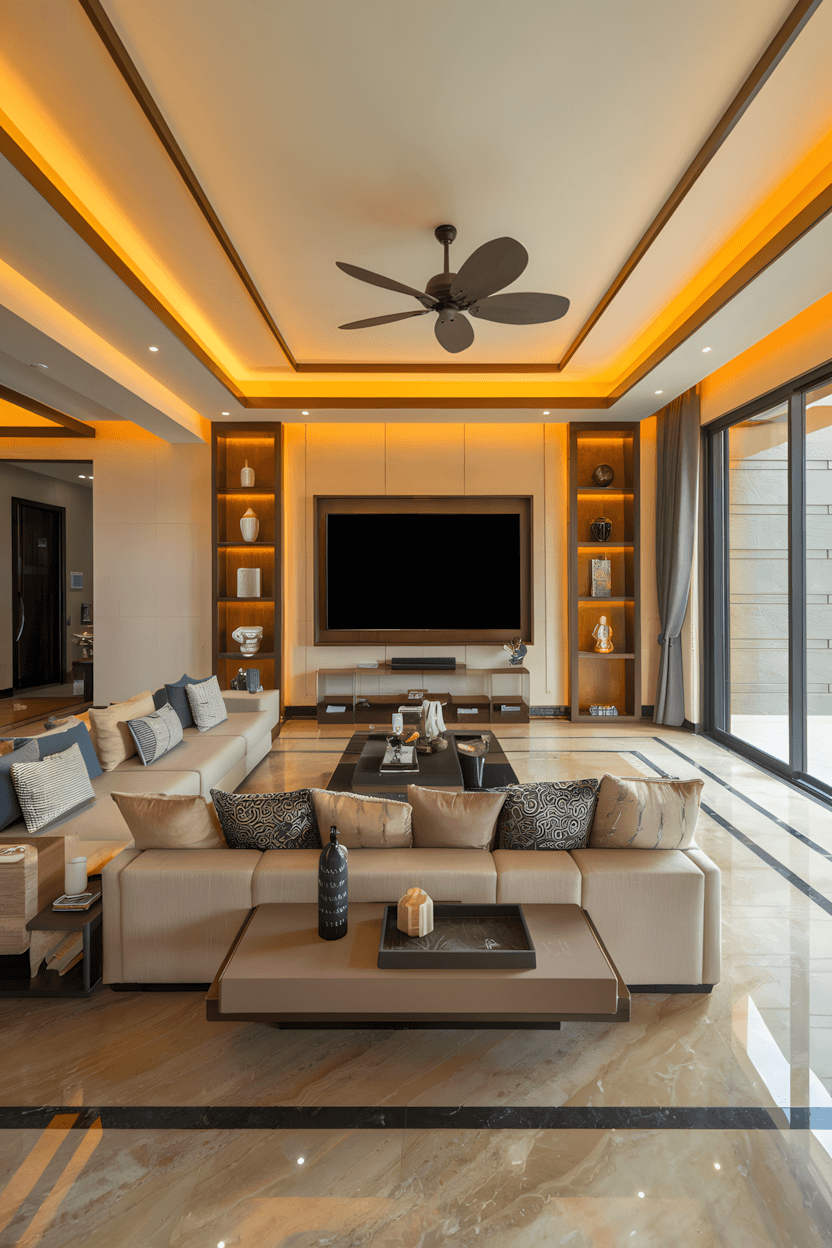
Amber-colored lighting can help transform spaces from daytime fresh to evening cozy. Sliding glass doors typically require adequate furniture clearance (often 36 inches minimum) for comfortable operation.
Indoor plants near glass doors may benefit from periodic rotation to encourage even growth. This attention to detail can help maintain healthy, attractive greenery.
Layout consideration: Rectangular coffee tables might work better than round ones when you have direct outdoor access, as they may not interrupt sight lines as much.
9. A Rustic-Contemporary Blend
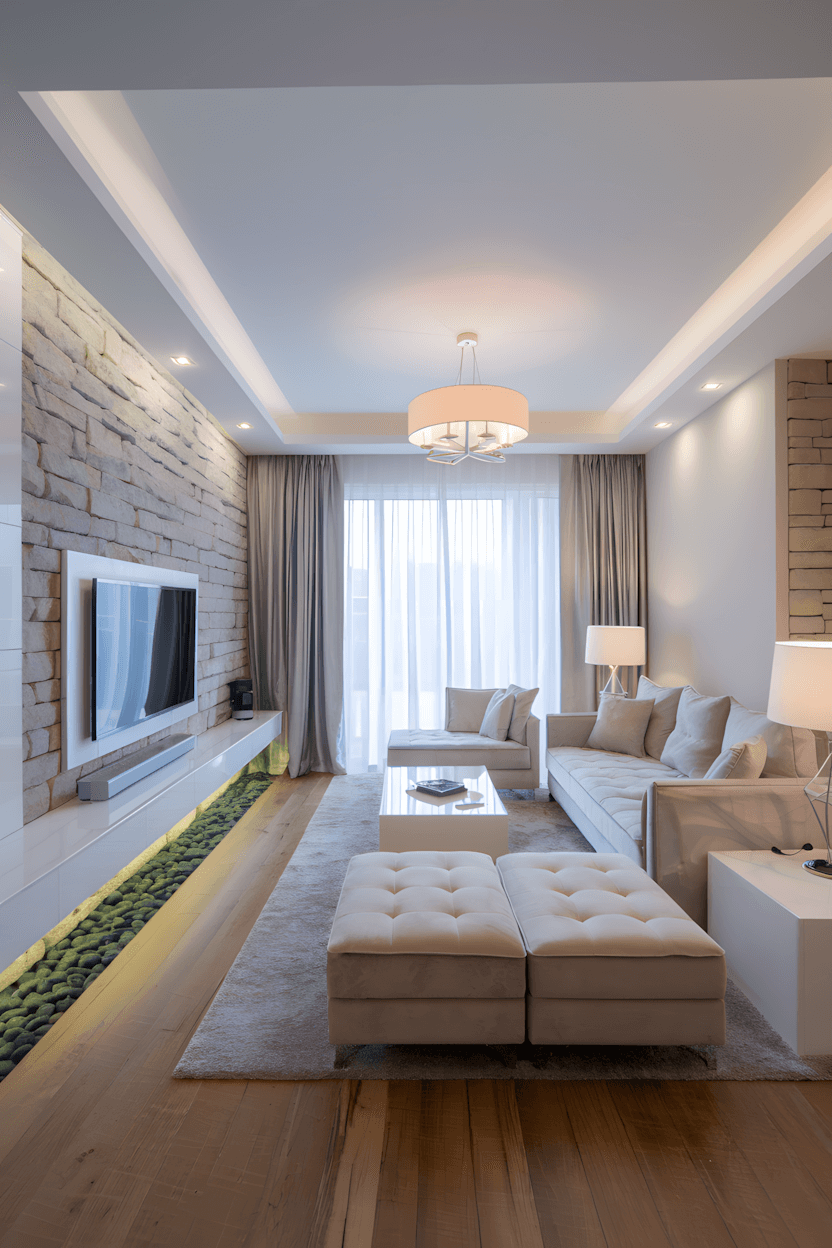
Stone accent walls create dramatic texture, but pebble-lit TV bases may require planning for bulb replacement access. Consider maintenance accessibility during the design phase.
When mixing wood tones, many designers suggest limiting finishes to two per room for harmony. TV mounting typically places the center at seated eye level (often around 42 inches from floor for standard seating).
Maintenance consideration: Stone walls generally need proper sealing to prevent water damage. Regular maintenance helps prevent costly repairs.
Professional installation note: Stone work and electrical installations require licensed contractors.
10. A Sleek and Serene White-Themed Space
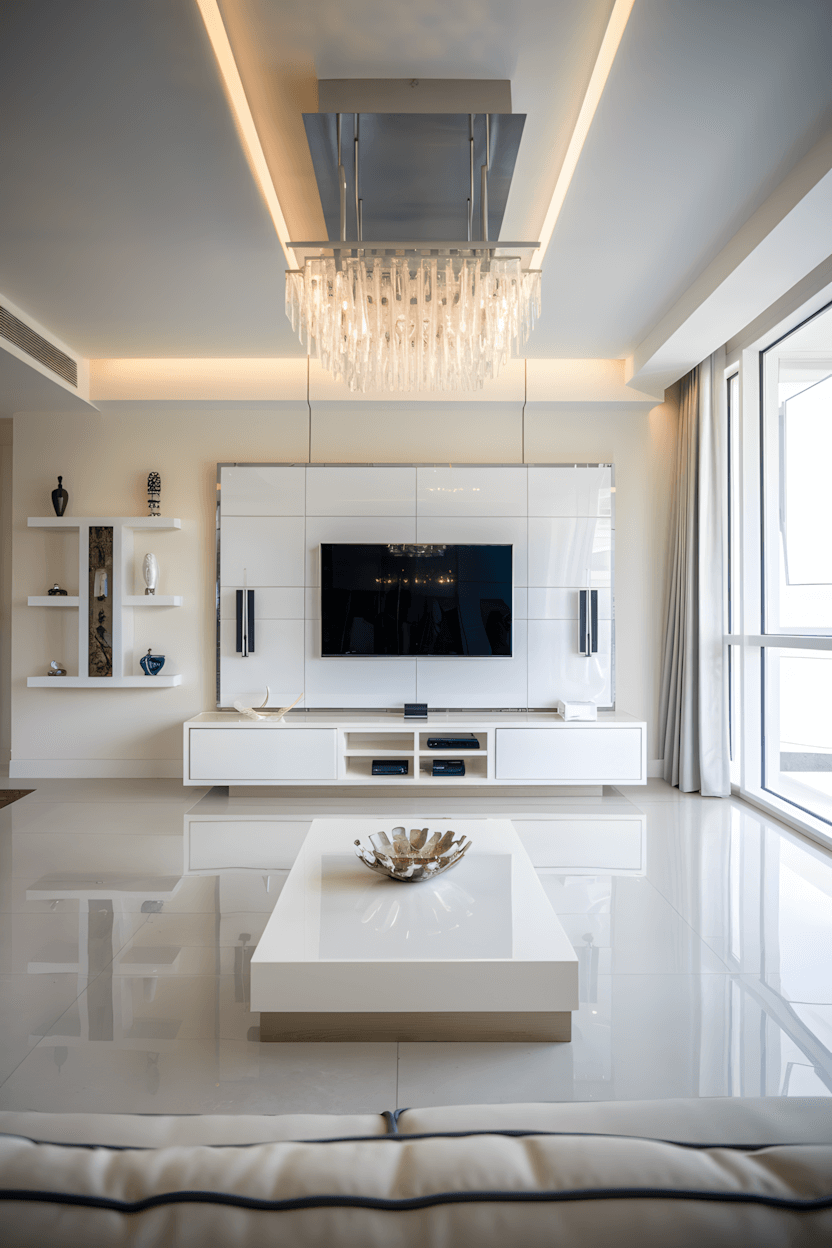
Preventing sterile feelings in white rooms often requires layered lighting and varied textures. Crystal chandeliers typically need adequate ceiling height (usually 8 feet minimum) for proper proportions and safety.
White decor generally requires more frequent cleaning but can photograph well for resale purposes. Using multiple fabric textures in white rooms often creates visual and tactile interest.
Practical note: Glossy surfaces show fingerprints readily—consider this finish primarily for formal spaces or if you don’t mind frequent cleaning.
11. A Playful Pop of Color
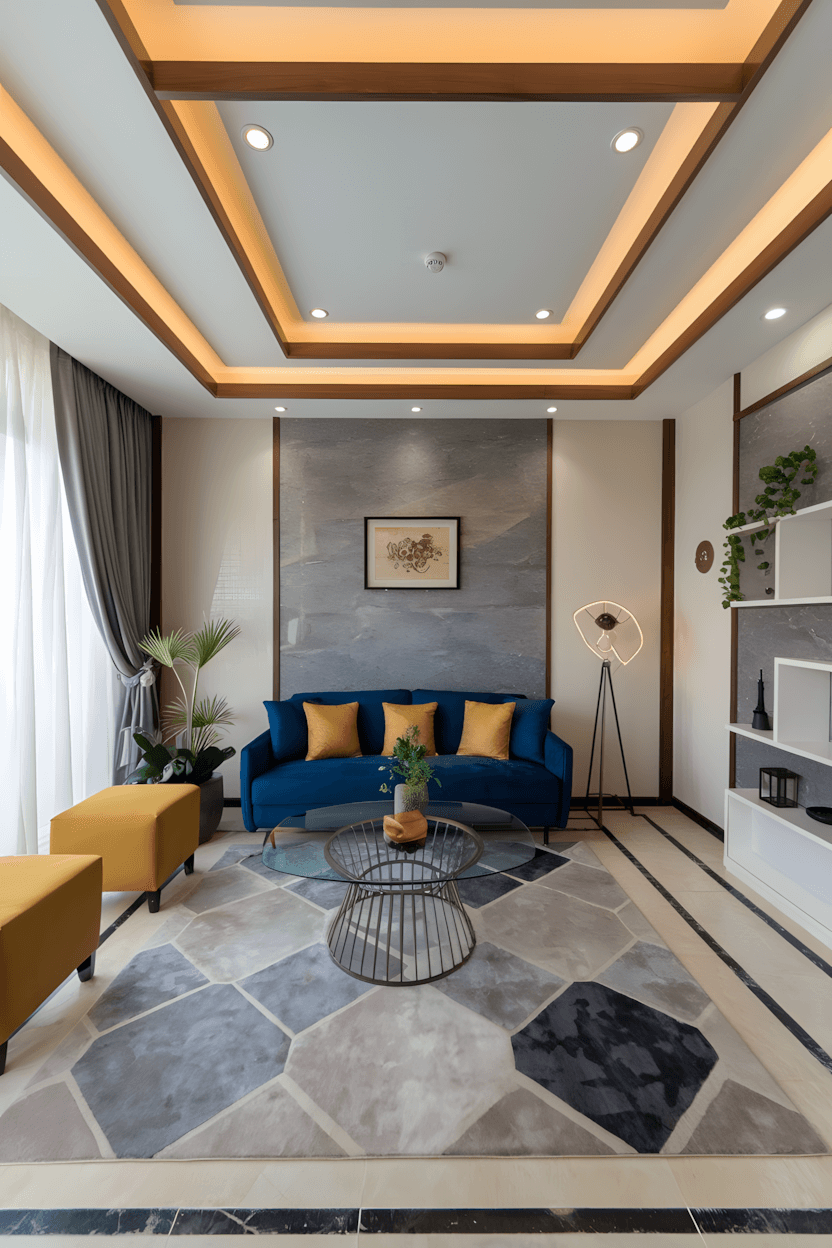
Blue and yellow combinations often work well in rooms with good natural light—this palette may appear less vibrant in north-facing spaces. Yellow fabrics may fade faster than other colors, so fade-resistant options might be worth considering for longevity.
Gray accent walls can provide neutral buffers between bold colors, potentially reducing visual tension.
Pattern approach: When mixing patterns, varying scale (combining small, medium, and large patterns) often creates harmony rather than competition.
12. A Sophisticated Balance of Textures
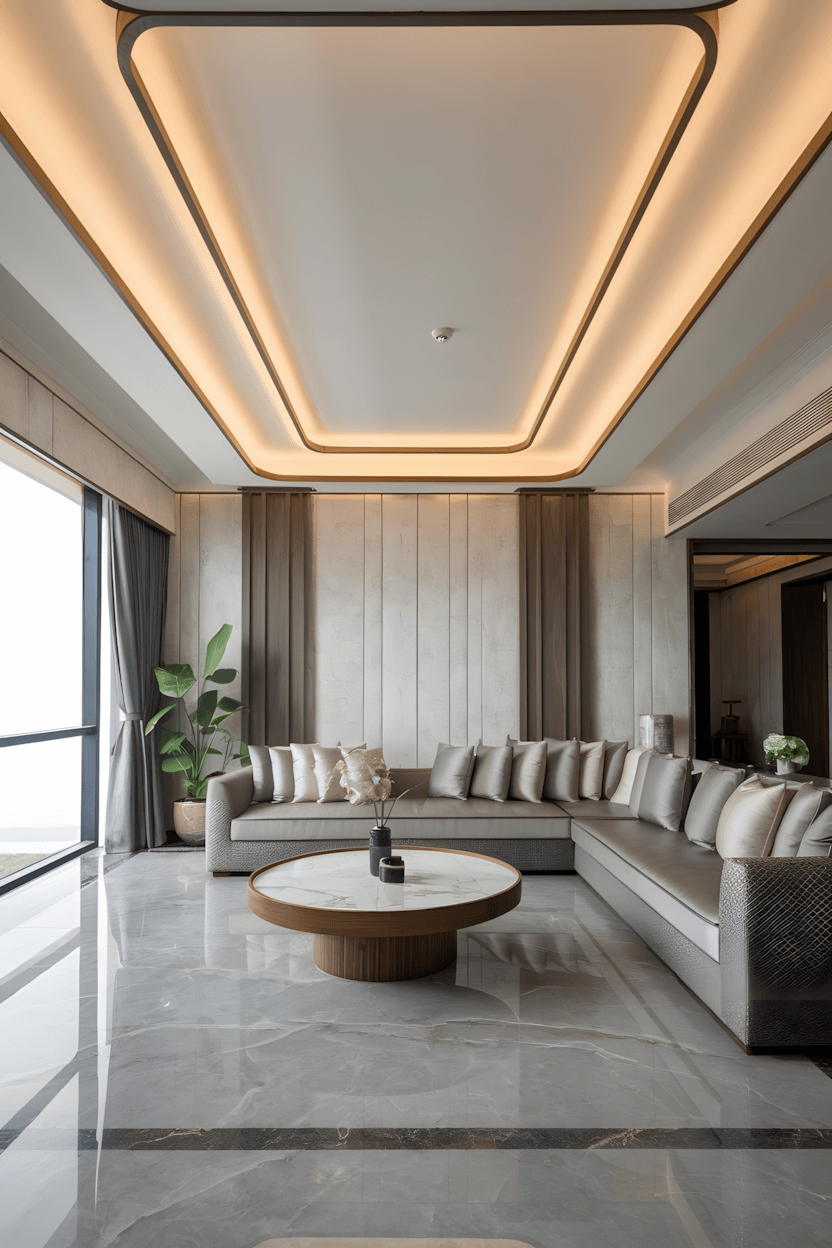
Marble-topped coffee tables can look stunning but may show fingerprints and water rings easily. These might work better for formal spaces or for those who don’t mind regular maintenance.
Textured wallpapers add visual depth without color commitment. Removable options might be practical for rental properties or those who change preferences frequently.
Design philosophy: Consider specifying materials based on lifestyle needs first, aesthetics second, to avoid beautiful but impractical choices.
13. A Warm and Inviting Retreat
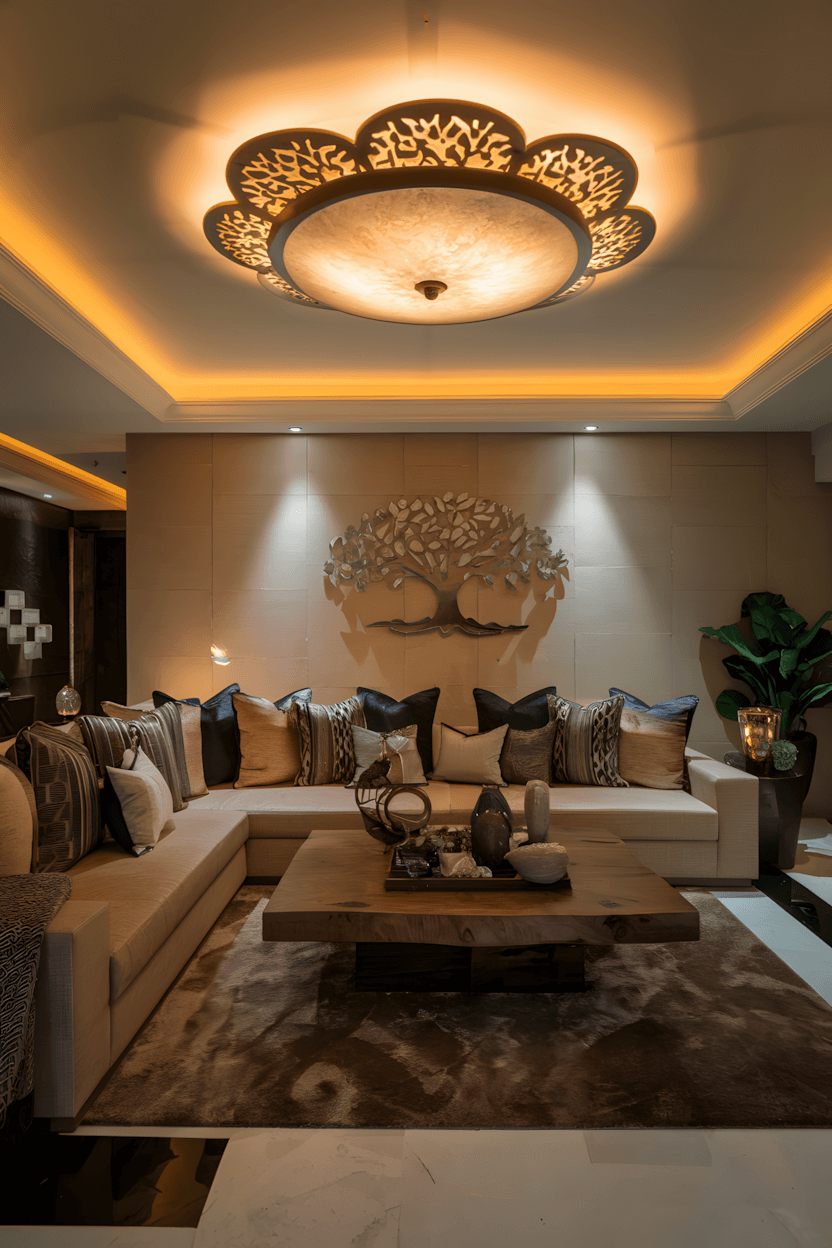
Unique ceiling light fixtures can create ambient warmth that transforms a room’s feeling. When using patterned cushions, mixing different scales (small, medium, and large patterns) often creates visual harmony.
Wooden coffee tables generally benefit from protective finishes for daily family use. Floor cushions might work well in adult-only households but could be impractical with pets or small children.
Comfort consideration: Statement armchairs should ideally be tested for actual sitting comfort, not just visual appeal, since uncomfortable seating can defeat the room’s purpose.
14. A Contemporary Space with Curved Elegance
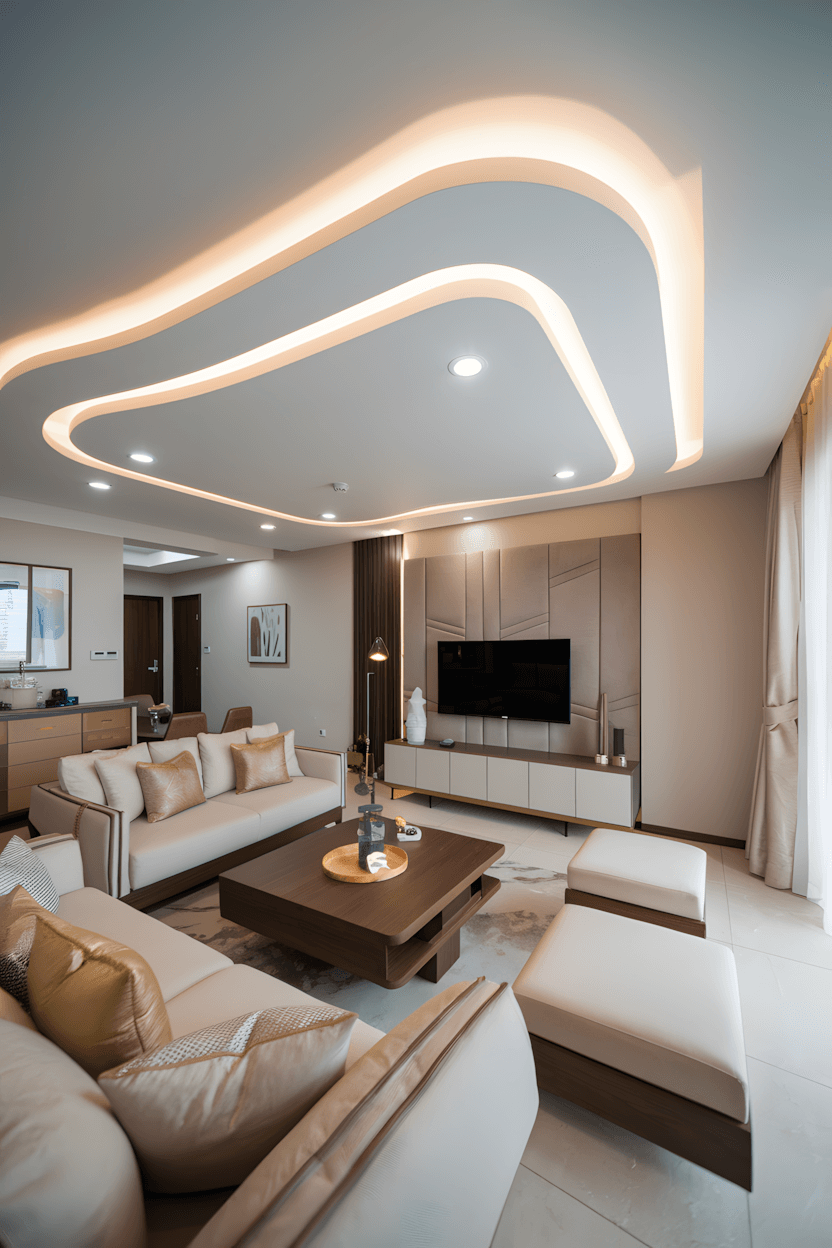
Curved furniture often costs more than linear pieces but may create psychologically calmer environments, according to some design psychology research. Curved ceiling designs require skilled installation but can dramatically alter room perception.
Matching ottomans can provide flexible seating and storage—lift-top versions offer maximum functionality. Rounded furniture often works better in square rooms, while linear pieces might suit rectangular spaces.
Design psychology note: Some research suggests that soft, curved lines may promote relaxation, making this approach potentially suitable for stress-relief spaces rather than energizing work areas.
15. A Dynamic Space with Artistic Elements
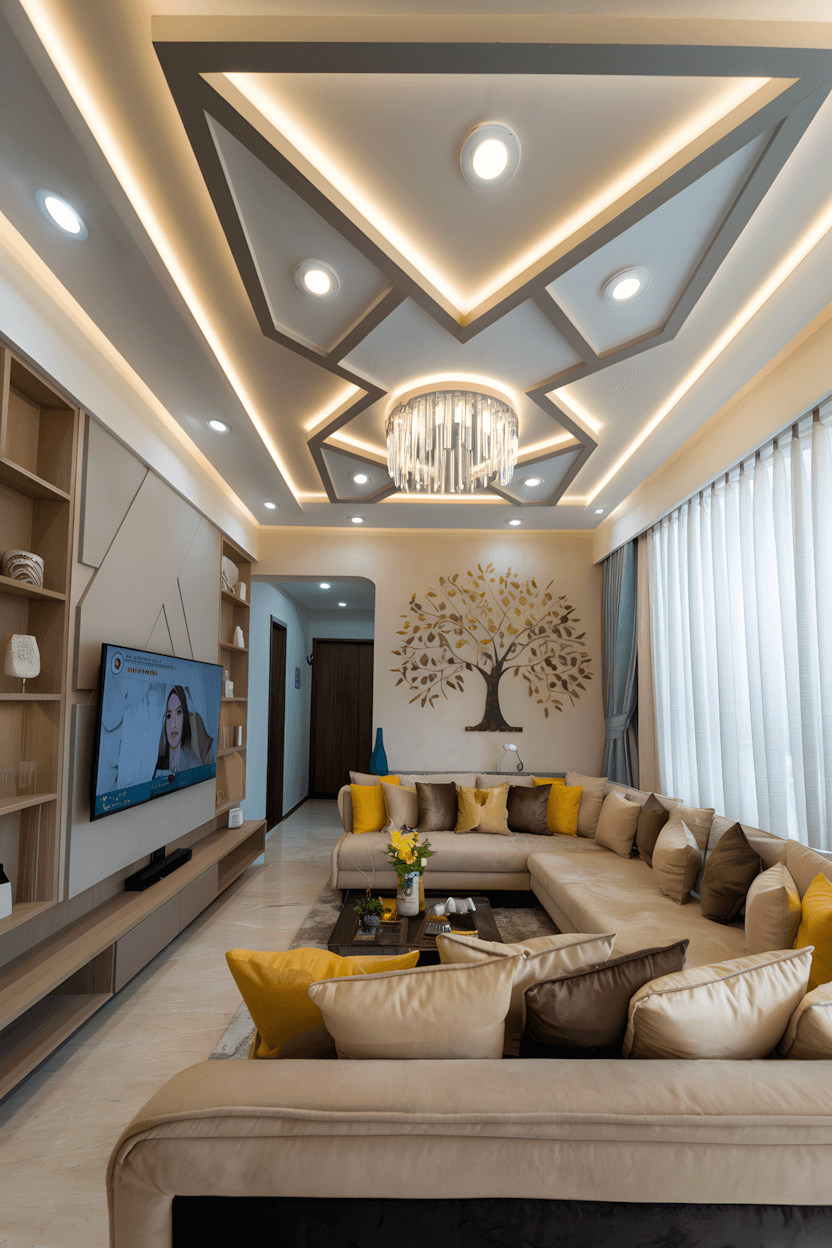
Geometric ceiling patterns create visual drama but might feel overwhelming in frequently used spaces. Crystal chandeliers generally require regular cleaning for optimal appearance.
Seasonal artwork like autumn trees can be rotated periodically to prevent visual fatigue. This flexibility can keep rooms feeling fresh without major design changes.
Installation consideration: Geometric patterns typically require precise measurement and installation, as small errors can become obvious with repetitive patterns.
Professional installation recommended: Complex ceiling work requires skilled contractors.
16. A Cityscape View with a Modern Aesthetic
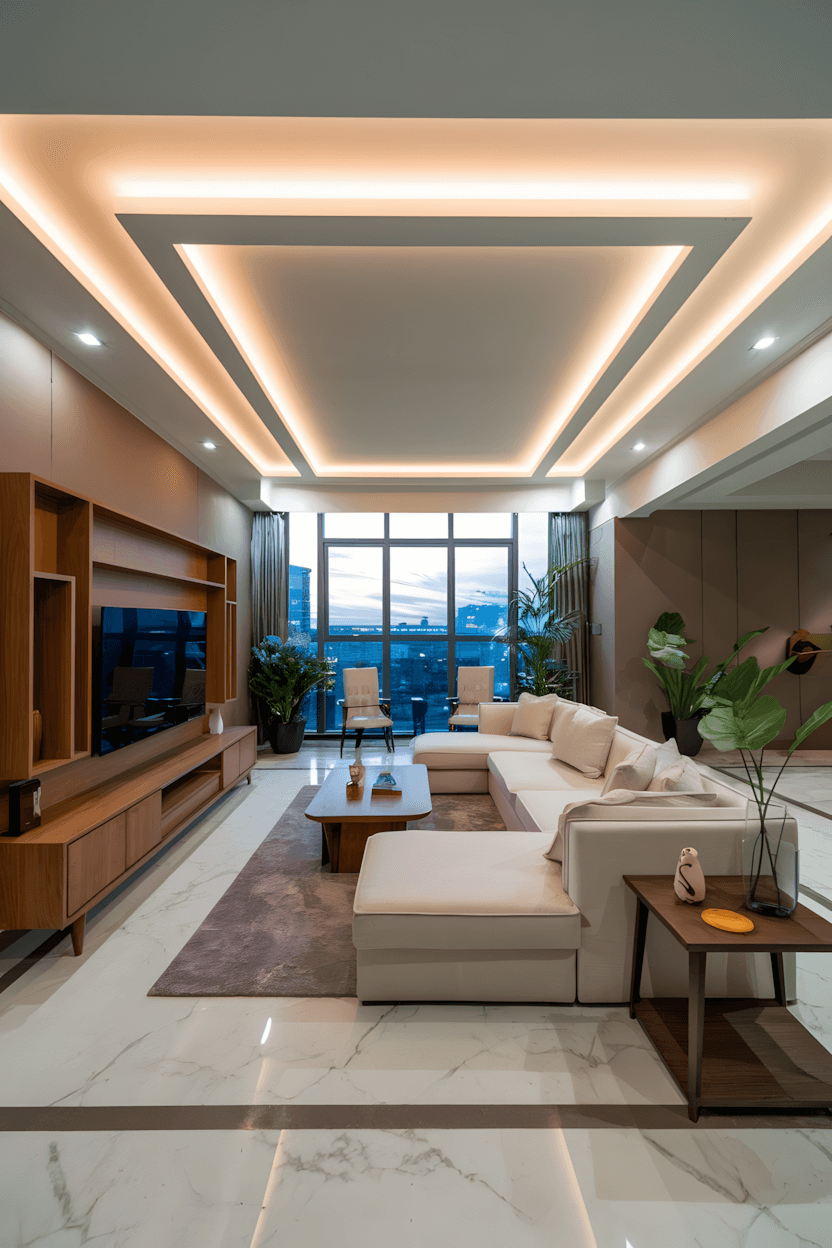
Large windows may benefit from UV protection treatments to prevent furniture fading. Wooden entertainment units can help ground spaces against expansive views.
Floor-to-ceiling curtains often frame city views dramatically while providing privacy control. City views change seasonally, so neutral furniture might work well year-round.
Layout suggestion: Consider positioning seating to capture good view angles while maintaining conversation groupings, so the view enhances rather than dominates social interaction.
17. A Minimalist Haven with Soft Lighting
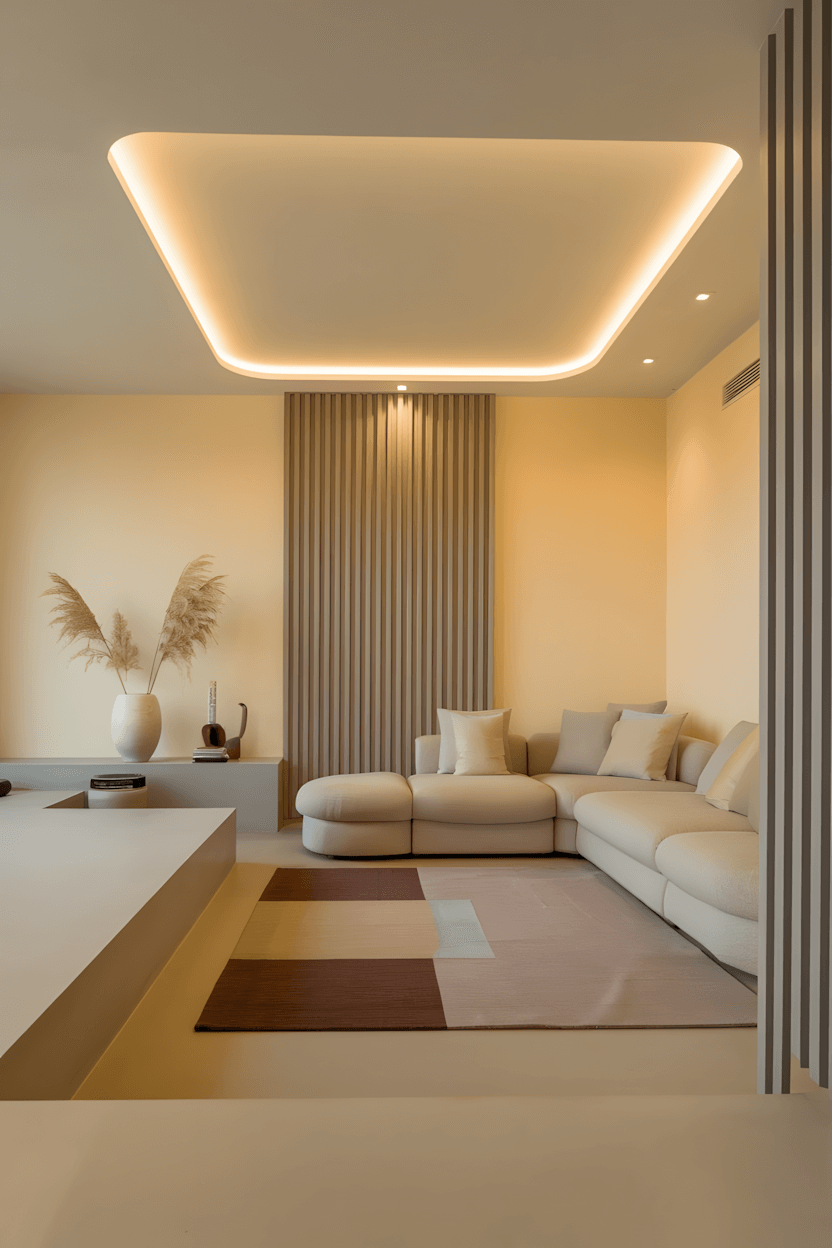
Soft yellow accent walls may promote relaxation, according to some color psychology research. Geometric recessed lighting can create architectural interest without overwhelming clean lines.
Multi-colored rugs often anchor minimalist spaces effectively. Limiting rugs to three colors or fewer might help maintain visual cohesion while adding warmth.
Lighting control: Individual dimmer switches for geometric recessed lighting can provide customizable ambiance for different activities.
Color psychology reference: Research in environmental psychology suggests certain colors may influence mood, though individual responses can vary.
18. A Harmonious Fusion of Comfort and Style

White sectionals may show wear more readily—performance fabrics might be worth considering for active families. Adjacent dining areas can extend entertaining space without requiring separate furniture investments.
Colorful cushions allow personality expression while maintaining neutral investment pieces. Open shelving typically requires careful styling to avoid cluttered appearances.
Space definition: Area rugs can help define separate zones in open concepts without physical barriers that might interrupt flow and light.
19. A Cozy and Earthy Sanctuary
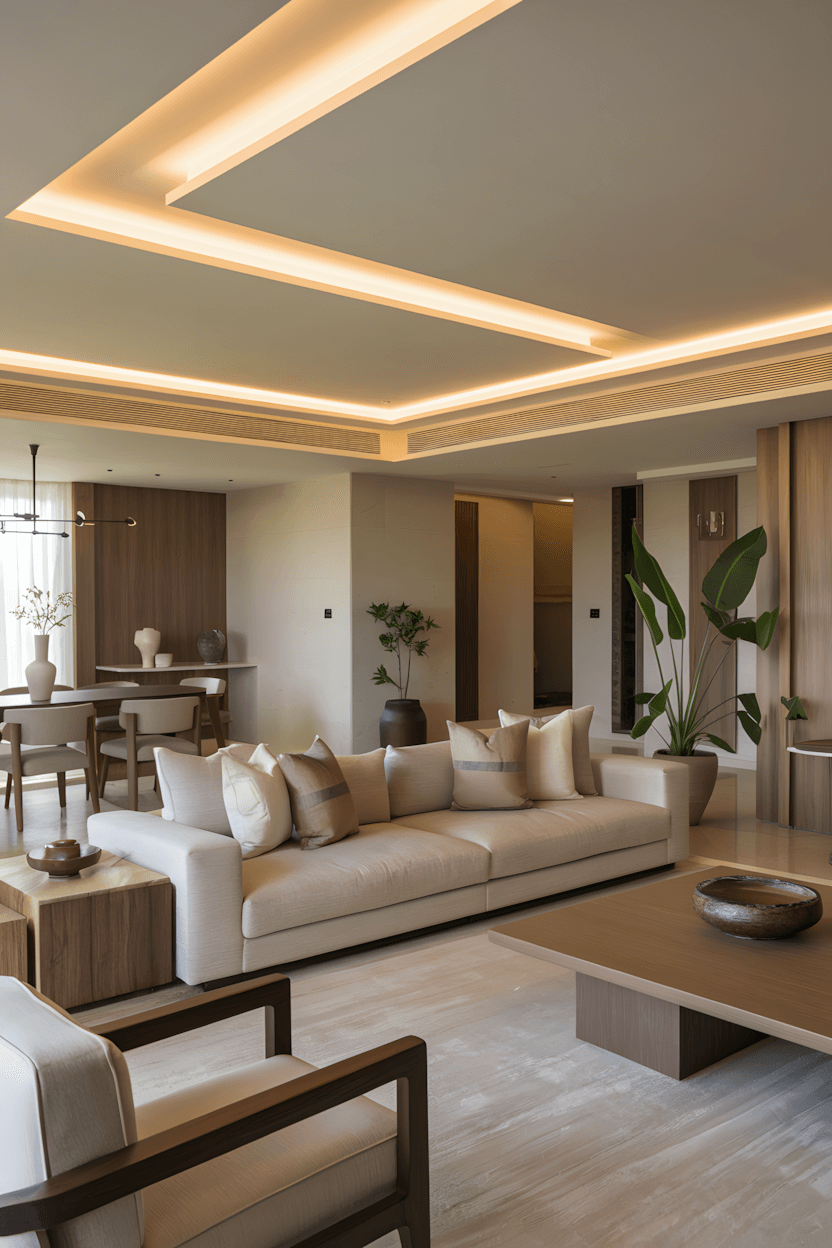
Wood-paneled walls often work best as accent features—full-room paneling might feel overwhelming in smaller spaces. Beige sofas may hide daily wear better than white options.
Darker piping or trim on light sofas might help with longevity. Wooden dining sets often look most harmonious when they match wall tones within a few shades.
Ambiance consideration: Dimmable lighting combined with candles can help transform day spaces into evening retreats, maximizing the room’s emotional appeal.
20. A Sleek and Functional Layout
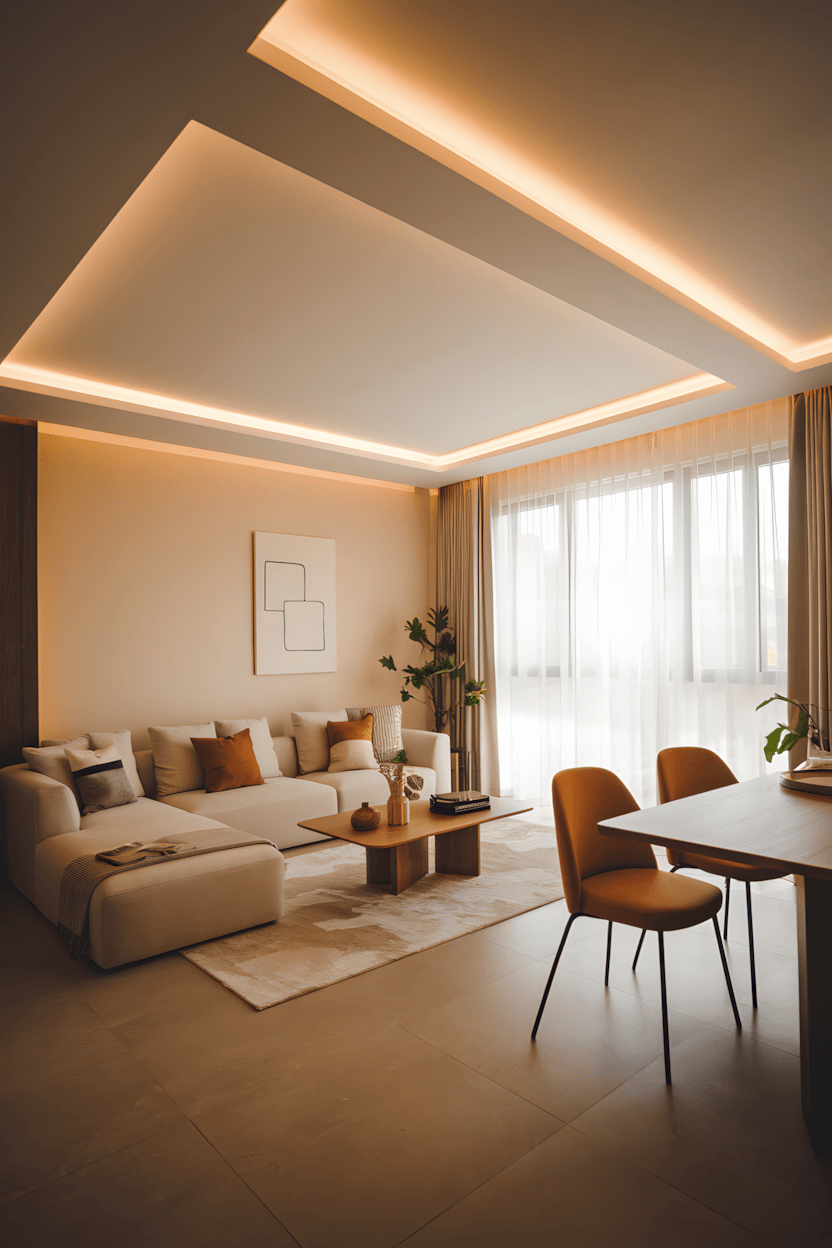
Open-concept layouts typically benefit from strategic furniture placement to define traffic paths without blocking movement. Maintaining adequate pathways (often 36 inches) between furniture groups can ensure comfortable navigation.
Minimalist artwork can prevent visual clutter while adding personality. Consider choosing pieces that complement rather than compete with existing architectural features.
Storage balance: Clean aesthetics shouldn’t necessarily sacrifice storage needs—hidden storage solutions might help maintain uncluttered appearances.
21. A Luxurious Retreat with Gold Accents

This approach often works best with consistent gold finishes—mixing different gold tones might create visual confusion. Sticking to one gold finish per room may help achieve cohesive elegance.
Quality sectionals represent significant investments but might prove worthwhile in frequently used spaces, as lower-quality alternatives may show wear more quickly.
Color strategy: Layering different shades of chosen earth tones rather than using single flat colors can create richness without overwhelming metallic accents.
Your Living Room Transformation: Next Steps
Based on various homeowner experiences, successful transformations often happen when you choose designs that match your actual lifestyle rather than aspirational ideals.
Consider starting with one element that genuinely excites you—whether it’s a statement light fixture or bold color choice—then building systematically around it.
These approaches often receive positive feedback because they aim to balance visual appeal with daily functionality.
Trust your instincts, consider investing in quality foundational pieces, and remember that the best living rooms typically evolve naturally over time rather than demanding immediate perfection.
Final reminder: Always consult licensed professionals for electrical work, structural modifications, heavy installations, and any work that may affect your home’s safety or building codes.


